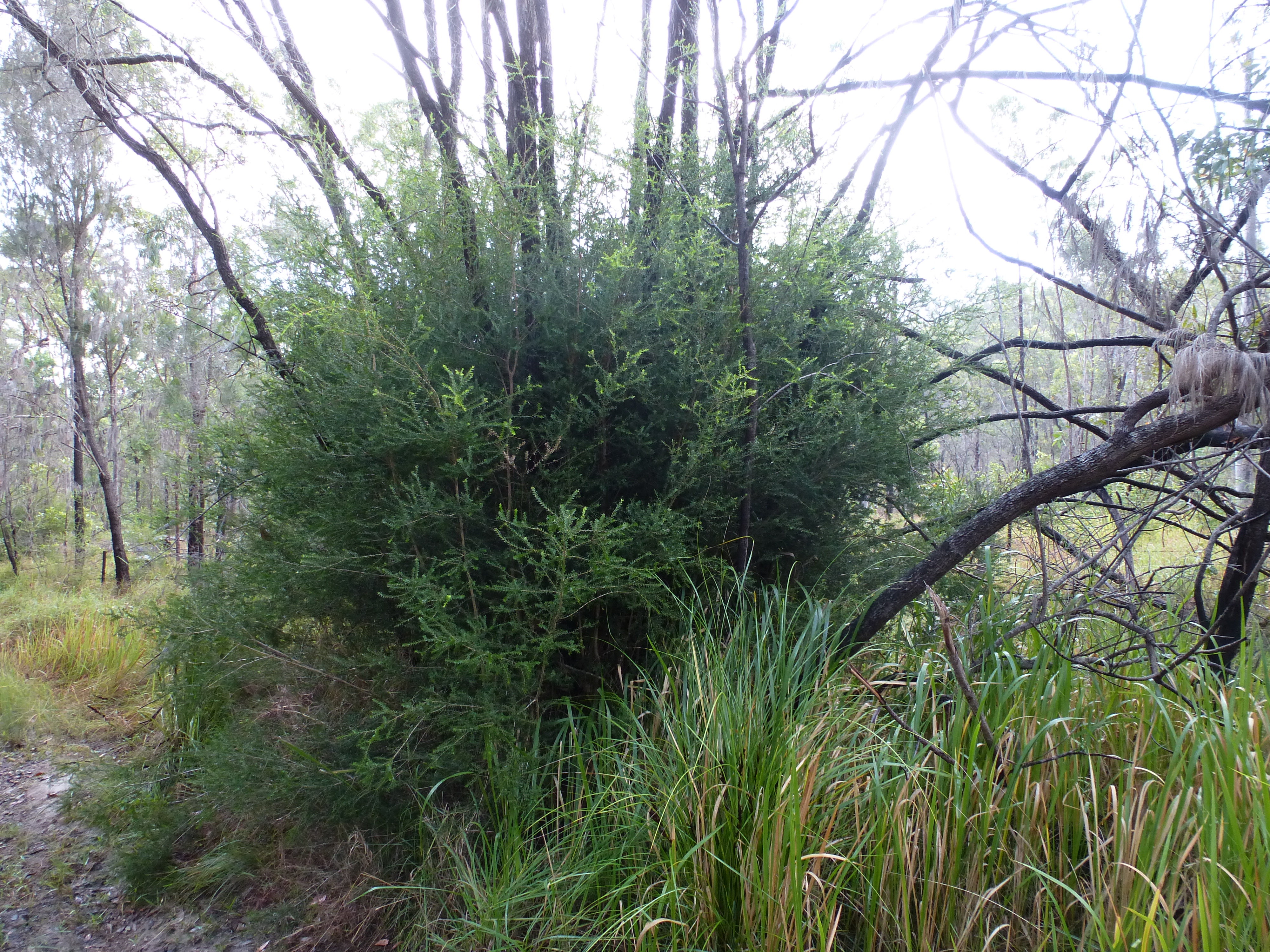Melaleuca Lophocoracorum on:
[Wikipedia]
[Google]
[Amazon]
''Melaleuca lophocoracorum'' is a plant in the myrtle family


Myrtaceae
Myrtaceae, the myrtle family, is a family of dicotyledonous plants placed within the order Myrtales. Myrtle, pōhutukawa, bay rum tree, clove, guava, acca (feijoa), allspice, and eucalyptus are some notable members of this group. All speci ...
and is endemic to a small area in the Ravenshoe State Forest, near Ravenshoe
Ravenshoe ( ) is a rural town and locality in the Tablelands Region, Queensland, Australia. In the , Ravenshoe had a population of 1,400 people.
Geography
Ravenshoe is on the Atherton Tableland in Far North Queensland. It is located south w ...
in Queensland. It is a newly described (2013) species of shrub or small tree with twisted leaves and spikes of cream-coloured flowers in summer. It is similar to ''Melaleuca squamophloia
''Melaleuca squamophloia'' is a plant in the myrtle Family (biology), family, Myrtaceae and is Endemism, endemic to the black soil plains of south eastern Queensland in Australia. Like its close relative ''Melaleuca styphelioides'', it is a small ...
'' and '' Melaleuca styphelioides''.
Description
''Melaleuca lophocoracorum'' is a shrub or small tree growing to a height of . Its leaves are arranged alternately, long, wide, egg-shaped, twisted, tapering to a sharp but not prickly point. The flowers are cream-coloured and arranged in spikes on the ends of branches which continue to grow after flowering and also on the sides of the branches. The spikes are up to in diameter, long and contain 3 to 9 groups of flowers in threes. Thestamen
The stamen (plural ''stamina'' or ''stamens'') is the pollen-producing reproductive organ of a flower. Collectively the stamens form the androecium., p. 10
Morphology and terminology
A stamen typically consists of a stalk called the filame ...
s are arranged in five bundles around the flower with 15 to 25 stamens per bundle. Flowers appear in December and January and are followed by fruit which are woody capsules long. The fruit retain the seeds for more than 3 years or until the plant is burned or the part bearing the fruit dies. The sepals remain as teeth around the edge of the fruit, usually for more than a year.
Taxonomy and naming
''Melaleuca lophocoracorum'' was discovered in 2012 and first formally described in 2013 by Andrew Ford, Lyn Craven and Joe Brophy in '' Telopea'' from a specimen collected on the walking track to Bally Knob near Ravenshoe. Thespecific epithet
In taxonomy, binomial nomenclature ("two-term naming system"), also called nomenclature ("two-name naming system") or binary nomenclature, is a formal system of naming species of living things by giving each a name composed of two parts, bot ...
(''lophocoracorum'') is from the Ancient Greek word ''lophos'' meaning “crest” and ''korax'' meaning "raven", because "hoe" in "Ravenshoe" originally meant "ridge" or "crest of a hill", so that ''lophocoracorum'' is equivalent to ''Ravenshoe''.
Distribution and habitat
This melaleuca is only known from an area of less than near Ravenshoe, where there are thought to be no more than 600 individual plants. It grows in forest, generally in poorly-drained or swampy soil onrhyolite
Rhyolite ( ) is the most silica-rich of volcanic rocks. It is generally glassy or fine-grained (aphanitic) in texture, but may be porphyritic, containing larger mineral crystals (phenocrysts) in an otherwise fine-grained groundmass. The mineral ...
rock near creeks. There seems to be a correlation between the size of the plants and the depth of the soil in which they grow.
Ecology
Response to fire
After fire, ''M. lophocoracorum'' resprouts at the stem base and along stems fromepicormic buds
An epicormic shoot is a shoot growing from an epicormic bud, which lies underneath the bark of a trunk, stem, or branch of a plant.
Epicormic buds lie dormant beneath the bark, their growth suppressed by hormones from active shoots higher up ...
.
References
{{Taxonbar, from=Q20721557 lophocoracorum Myrtales of Australia Flora of Queensland Plants described in 2013